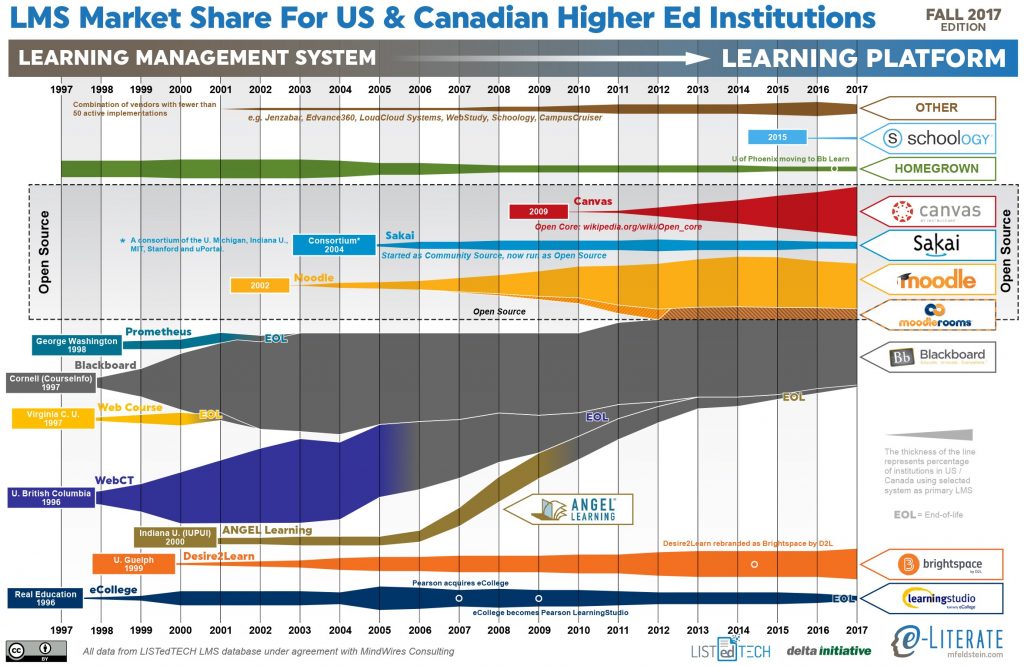
Editor’s Picks
Community Colleges, Early Adopters of Online Technology, Hint at New LMS Market Trends
By Henry Kronk
February 25, 2018
Studying the learning management system (LMS) market has never been easy. In many cases, similar software products can be applied to strikingly different settings. Generally, these settings could be described as K-12, higher education, and corporations. But within each, countless variations exist. Some LMSs go for broad appeal; others go for specialization. For this reason, it’s both difficult and reductive to clump all LMSs into one study.
But every now and then, data comes along that is both specific and broad enough to make a splash. Earlier this month, the Instructional Technology Council (ITC), a subsidiary organization of the American Association of Community Colleges (AACC), released their annual report titled “Trends in eLearning: Tracking the Impact of eLearning at Community Colleges.” Besides providing a great deal of excellent information on the current state of community colleges in the U.S. and Canada, the report detailed a good deal of recent trends of LMSs at community colleges.
In a sense, LMS activity in North American community colleges can stand in for larger trends. A couple figures match up pretty exactly and don’t offer any surprises. Other takeaways, however, seem to come out of left field.
What’s more, North American community colleges don’t just represent one LMS market; they were the first one. When online programs and remote degrees began to really proliferate in the mid-‘90s, community colleges were the first higher ed group to truly embrace the model. True, community colleges have come to represent a smaller and smaller sector of LMS clients, but they’re also a historically forward thinking group. Their activity today might just continue to prove a weathervane of trends to come.
The Latest LMS News from Community Colleges
To begin, the market share distribution in community colleges is roughly the same as the zoomed-out, all-encapsulating reports. The big four among the CCs follow as such: Blackboard is the leader with 40%, next comes Canvas by Instructure at 27%, then it’s Moodle at 17%, and in fourth at 14% comes Brightspace by D2L (Desire2Learn). The ITC report doesn’t make it clear whether or not their survey represents market share by number of institutions or enrollment, but either way, it’s pretty close to both Edutechnica and LISTedTECH’s joint report with e-Literate. Both reports include data as recent as the fall of 2017.

Like other reports, Moodle and D2L haven’t reported huge gains or losses, and Canvas continues to make inroads, snapping up bits and pieces of Blackboard’s share. This is a very general summary: Moodle, for example, has dropped as low as 12% in 2016 and others have fluctuated by more. But none have demonstrated growth as consistent as Canvas’.
Disruption Gives Way to Stability
But surprisingly, while it seems elsewhere that LMSs are in a state of disruption and fluctuation, the ITC came to a different conclusion:
“The 2017 survey confirmed a new trend in LMS adoptions – stability. Again this year, only 24% indicated they were considering changing their LMS; consistent with the 25% of respondents in 2016 that reported their college was considering switching to a different LMS in the next few years. This is now a five year trend of reduced turmoil in LMS adoptions. More historically, it was normal for approximately one-third of programs to be looking to switch. This year, 78% of respondents reported that their college restricts the number of LMS platforms it will support, up from the 68% reported last year and consistent with the 76 percent reported in 2015. The data confirms a significant majority of colleges will support only one LMS.”
When Canvas came on the scene with the first could-native LMS, they were able to snap up a lot of expiring Blackboard contracts by offering lower costs and easier maintenance. But maybe that advantage has begun to die out.
But another factor refutes this. In an LMS satisfaction survey issued to community colleges that addressed a dozen different categories, institutions were, by far, least satisfied with their LMS analytics and reporting. It might be a coincidence, but Gauge, another product by Instructure, was released last summer. It significantly outpaces all other analytics and reporting services that couple with LMSs. It would be interesting to see which LMS users reported satisfaction. They might just be all of the 27% of institutions that use Canvas plus a few others.
When it came to other forms of satisfaction, hosting and reliability also scored high, at 76% and 81.4% respectively.
Most LMS market share reports will zoom way out. ITC’s report provides a rare insight that includes both breadth and focus.








No Comments